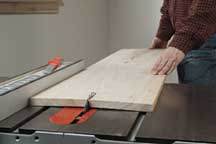
I made a cutout in the shape of the state of Ohio from a piece of 1/4″ walnut. The grain runs from top to bottom and that is where it cups. Can I cut groves in the back of the piece to stop this and and if I can, which way should I cut these groves? Top to bottom or side to side?
Michael Dresdner: Cutting grooves in the wood along the length of the grain will allow the board to flex, and enable you to force it flat, but that will not necessarily make it lie flat by itself. You could, however, groove it, then glue the now-flexible piece to a flat backer board, such as die board (a type of flat birch ply), MDF, or phenolic sheet, so that it is more likely to stay flat. Once the glue dries, finish the piece with something that has good moisture holdout (shellac or oil-based polyurethane) to help slow down movement due to moisture changes, and try to keep it in a stable environment.
Lee Grindinger: You’re asking a lot from a 1/4″ thick piece of wood. As moisture on one face increases, that face will expand. Since the opposing face isn’t expanding at the same rate, the piece cups. Whether it’s the topside or the underside depends on the relative humidity in the piece’s environment. A film-type finish, like varnish, will slow this movement but will not prevent it altogether. Obviously, flipping Ohio over isn’t an option, although it would be the best way to equalize the moisture. Your best option is to use quartersawn lumber for these sorts of projects. Quartersawn lumber is easily recognized because the end grain runs perpendicular to the face of the board. Quartersawn wood will resist this cupping. Cutting grooves in the back will work only if the cause of the cupping is stress in the lumber, either from growing or drying. Since you’ve nothing to lose, you can try grooving. Cut shallow grooves parallel to the grain.





